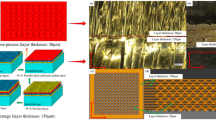Three main areas in the engineering of structural powder materials related to the control of pore-space morphology, formation of perfect contacts, and optimization of solid-phase structure are discussed. The causes behind the effect of pores on the strength of both brittle materials and materials with high fracture toughness are analyzed. The formation of high-quality contact is analyzed in the context of structurization and evolution of interparticle boundaries at different production stages. The structural optimization of powder materials is discussed considering, as an example, the grain refinement and formation of nanostructured materials.












Similar content being viewed by others
References
Yu. N. Podrezov, L. I. Chernyshev, N. I. Lugovoi, and D. G. Verbilo, “Structural sensitivity of the ultimate mechanical properties of biporous materials prepared using a pore-former,” Powder Metal. Met. Ceram., 38, No. 7–8, 403–407 (1999).
Y. N. Podrezov, N. I. Lugovoi, V. N. Slyunyaev, D. G. Verbilo, and L. I. Chernyshev, “Principles of the design of highly porous layered composites working in the bending mode,” Powder Metal. Met. Ceram., 39, No. 3–4, 171–177 (2000).
S. A. Firstov and Yu. N. Podrezov, “Effect of the pore space structure on deformation energy absorption during compression of high-porosity composites. Part I. Low hardening stage,” Powder Metal. Met. Ceram., 39, No. 7–8, 407–413 (2000).
Yu. N. Podrezov, M. P. Brodnykovsky, L. I. Chernyshev, and M. Szafran, “Non-elastic behavior of high-porous ceramic,” Polish Ceram. Bull., 69, 71–82 (2002).
Yu. N. Podrezov, D. G. Verbilo, E. M. Borisovskaya, and M. Szafran, “Mechanical behavior and damping parameters of high-porous ceramic materials,” Ceramics, 89, 162–175 (2005).
A. S. Drachinskii, A. E. Kushchevskii, A. V. Perepelkin, Yu. N. Podrezov, V. A. Reitor, V. I. Trefilov, I. M. Fedorchenko, and S. A. Firstov, “Effect of porosity on the resistance of P/M iron to cracking,” Powder Metal. Met. Ceram., 21 No. 12, 973–977 (1982).
S. A. Firstov, Yu. N. Podrezov, L. G. Shtyka, et al., “Modeling of the ductile–brittle transition in porous metallic materials under conditions of crack resistance tests,” Powder Metal. Met. Ceram., 29, No. 5, 411–416 (1990).
Yu. N. Podrezov and L. G. Shtyka, “Structural sensitivity of the mechanical properties of powder materials,” in: Physics and Mechanics of Powder Materials [in Russian], Inst. Probl. Materialoved. NAN Ukrainy, Kyiv (1993), pp. 15–32.
J. Gurland and N. M. Parikh, “Microstructural aspects of the fracture of two-phase alloys,” in: H. Liebowitz (ed.), Fracture. An Advanced Treatise, Vol. 7, Academic Press, New York (1969), pp. 842–879.
G. T. Hahn and A. R. Rosenfield, “The influence of a fine dispersion on the cleavage strength of iron,” Trans. AIME, 239, 668–674 (1967).
S. A. Firstov (ed.), A. N. Demidik, I. I. Ivanov, et al.; Structure and Strength of Powder Materials [in Russian], Naukova Dumka, Kyiv (1993).
Yu. M. Podrezov, V. A. Nazarenko, Ya. I. Evich, and A. V. Vdovichenko, “Mechanical properties of powder titanium at different production stages. III. Contact formation in powder titanium based on examination of mechanical properties in sintering,” Powder Metal. Met. Ceram., 48, No. 3–4, 201–110 (2009).
Yu. N. Podrezov, V. A. Nazarenko, A. V. Laptev, et al., “Mechanical properties of powder titanium at different production stages. IV. Mechanical properties and contact formation in powder titanium produced by dynamic hot pressing,” Powder Metal. Met. Ceram., 48, No. 5–6, 295–301 (2009).
N. I. Danilenko, B. V. Borts, Yu. N. Podrezov, et al., “Analytical electron microscopy of nano-interlayers in the contact region of metals hot-rolled in vacuum,” Naukovi Notatki, 31, 109–114 (2011).
A. V. Laptev, L. A. Kryachko, A. I. Tolochin, et al., “Comparison of the structure and mechanical properties of ordinary and ultrafine Ag30Ni composites produced by impact sintering,” Metallofiz. Noveish. Technol., 34, No. 10, 1351–1360 (2012).
V. V. Skorokhod, A. V. Ragulya, and R. A. Andrievskii, “Rate-control sintering of nanocrystalline TiN powders,” Nano-Struct. Mater., No. 10 (1997).
V. V. Skorokhod, I. V. Uvarova, and A. V. Ragulya, Physicochemical Kinetics in Nanostructured Systems [in Ukrainian], Akademperiodika, Kyiv (2001).
L. A. Poznyak, K. A. Gogaev, V. A. Shtakun, et al., “Determining the resistance to deformation in hot processing of high-speed powder steels,” in: High-Speed Powder Steels [in Russian], Inst. Probl. Materialoved. NAN Ukrainy, Kyiv (1990), pp. 88–96.
O. I. Getman, V. V. Panichkina, V. V. Skorohod et al., “Diffusion processes in Ba–Sr–titanate system under microwave heating,” Key Eng. Mat., 206–213, 389–392 (2002).
K. A. Gogaev and V. I. Ul’shin, Powder Metallurgy of Tool Steels [in Russian], Noulidzh, Donetsk (2012).
Yu. N. Podrezov V. A. Nazarenko, A. V. Laptev, et al., “Structural dispersion of powder titanium in the optimal conditions of dynamic hot pressing,” Powder Metal. Met. Ceram., 51, No. 1–2, 56–63 (2012).
J. E. Beygelzimer, “Simple shear of metals: What is it?” Fiz. Tekhn. Vysok. Davl., 20, No. 4, 40–52 (2010).
I. I. Ivanova, A. N. Demidik, and A. A. Sotnik, “Activation of alloy formation in powder two-component systems by hot deformation,” Powder Metal. Met. Ceram., 40, No. 3–4, 144–148 (2001).
I. I. Ivanova and A. N. Demidik, “Development of technology to obtain pore-free powder metallurgy alloys of the nickel–molybdenum system,” Powder Metal. Met. Ceram., 40, No. 5–6, 242–245 (2001).
Author information
Authors and Affiliations
Corresponding author
Additional information
Translated from Poroshkovaya Metallurgiya, Vol. 51, No. 11–12 (488), pp. 75–87, 2012.
Rights and permissions
About this article
Cite this article
Podrezov, Y.N. Structural Engineering of Powder Materials. Powder Metall Met Ceram 51, 677–686 (2013). https://doi.org/10.1007/s11106-013-9483-0
Received:
Published:
Issue Date:
DOI: https://doi.org/10.1007/s11106-013-9483-0




